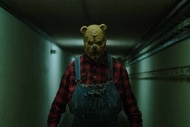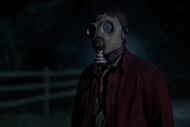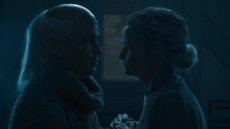Create a free profile to get unlimited access to exclusive videos, sweepstakes, and more!
The bizarre backstory of Doom Patrol's Rita Farr

The Doom Patrol is notorious for being one of the most truly bonkers superteams ever, and while the quality of the stories has been a real mixed bag over the decades, this is one series that is never boring. Whatever era you pick up, good or bad, the chances are that you won’t walk away from reading it with feelings of indifference. Best known for being one of the early books on which Grant Morrison made his name, Doom Patrol goes back much further and means much more to comics history than its status as a key title of a superstar creator.
Having both began in 1963, it is widely assumed that the X-Men are directly derivative of the Doom Patrol, and this isn’t easy to argue against — Doom Patrol features a control freak father figure whose ethics become more questionable over time, living in a mansion with people he mentors who can’t fit in with “regular” society due to their powers and appearances. Doom Patrol premiered in June while the X-Men showed up in September. It could easily be a big coincidence, but you have to admit, the similarities are there.
Yet, one thing sets Doom Patrol apart from many of the comics of the time besides just being even stranger than the X-Men, and that is one Rita Farr. While the X-Men’s Jean Grey, then known as Marvel Girl, was frustratingly underdeveloped for a significant portion of the early comics and seldom helpful in fight scenes, Rita Farr was a former Olympian, a star actor, and trained stuntperson, and her first appearances were notably more empowered than those of contemporary heroes like Sue Storm of the Fantastic Four, or even Wonder Woman.
Paradoxically, when Doom Patrol drew to a close, Rita mostly vanished from the franchise. For years, she was seen only in guest appearances, and she did not appear in the Grant Morrison run. Many clumsy attempts at reboots followed, only to bring us to the present day Doom Patrol TV series, where we're finally getting the Rita Farr we've been hoping for after all this time. It was a heck of a journey to get here, though, so here is a condensed version of some of the highs and lows of being a Rita Farr fan over the years.
Strange OriginsThe adventures of the Doom Patrol began in a series called My Greatest Adventure, which ran for many issues as an anthology of sci-fi stories before their introduction. Seeming almost like an afterthought in their own series, they stood far apart from the superheroes of their day. The comics code and the national backlash against comics of the mid-'50s had helped to limit much of the wide range of subject matter comics once held — this is when American comics began to focus on superheroes above other genres. This came about partly because many of the other publishers were put out of business thanks to code censorship, particularly horror comics. In contrast, publishers like DC had managed to hold on by a thread as they continued printing the still successful Batman and Superman series. Meanwhile, Timely Comics, soon to become Marvel, would revitalize superhero comics in the early ‘60s with characters like Spider-Man, who famously focused on a young, neurotic teenager rather than handsome billionaires. More bizarre heroes like Doctor Strange and the Hulk began popping up, and comics changed.
Even with all that context, Doom Patrol stands out as particularly weird. The group all had strange powers that forced them to distance themselves from humanity and live in seclusion at stately Doom Manor with their “mentor,” the Chief — who, inevitably, would go on to display some unsettling tendencies towards villainy. With even their mentor being essentially a monster himself, their bickering and unprofessionalism alongside their strange appearances and lack of training ensured that they could never hope to successfully meld with the world of "regular" superheroes. Still, they try, and that’s what fans have always loved about this team.
Rita Farr was a Hollywood actor whose powers emerged when she was exposed to mysterious volcanic gases while shooting a film in Africa (comics of the ‘60s never pinpoint what region exactly in the massive continent of Africa they’re talking about). Afterward, she developed the power to change size (although the more obscene and disturbing aftereffects of her powers reducing her to a boneless blob as seen in the Doom Patrol TV series are more recent developments). Rita had a fair temper, and she rebuffed the advances of her teammates while focusing on her ambitions for superheroism, living in a state of somewhat desperate denial that we still see from her to this day. The original series didn’t go extremely in-depth on characterization, focusing instead on its sci-fi elements and the introduction of incredibly weird villains like The Animal-Vegetable-Mineral Man or The Brain, but for comic characters of the time, Rita holds up pretty well, and she is easily just as capable, fallible, and strange as the rest of the team. Perhaps most importantly, this is a character who is a beautiful woman, who is sexualized by others, but who keeps a distance on her own sexuality and displays essentially asexual inclinations for most of her history. In her own personal life before the Doom Patrol, she was emotionally distant and career-oriented above all.
Everything goes downhill when the billionaire Steve Dayton is introduced to the group. He invented a special mind control helmet to use to win over the famous Rita Farr, and he succeeds, despite how unbelievably creepy the vibes around that are. She and Steve are married, which essentially eliminates any autonomy she had developed with the team. They adopt Beast Boy, who of course later becomes one of the Teen Titans, and there is a short time during which they all appear to be happy together, though this is indeed undermined by the presence of a literal mind control helmet. The series ended in 1968 when an explosion kills all the characters. This approach would be repeated often in the coming years, but for the history books, Doom Patrol was the first superhero group to end their series with their own deaths.
Aftermath and RebootsAfter the explosion that cost their lives, Beast Boy switched his name to Changeling and joined the Teen Titans in hopes of redefining himself beyond the Doom Patrol, and became a raging misogynist for about the next fifteen years. In the New Teen Titans, the focus on his tenuous relationship with Steve Dayton was centered. Changeling delighted in the luxury his inheritance from Steve granted him, but he resented his adopted father. For his part, Steve had long abused his mental powers and developed an unhealthy relationship with the helmet from which they came, and he soon escalated to full-fledged villainy. Eventually, Steve was “cured,” but instantaneous cures are not generally how one learns to come to grips with their own mental health struggles, so he soon reverted to type. He likely exacerbated his own struggles significantly with his overuse of the helmet, showing a dangerously addictive and abusive side to his personality that makes it nearly impossible to wish to see him ever reunite with Rita. Meanwhile, Beast Boy’s relationship with Rita remains significantly more nuanced. They maintain a healthy distance due to the pain they have mutually caused one another, but there is still a great deal of tenderness between the two.
Throughout the years and the many relaunches and guest appearances of the characters, inexplicably, no writers appeared to be particularly compelled to return Rita to the series she had helped define. Her teammates would all return and see new life at DC, but Rita would not, and indeed she was gone from comics until 2004. The fact that writers chose to revive and focus on Steve Dayton rather than Rita remains truly baffling on an almost profound level.
The Byrne run is not great for many reasons and is best ignored, but it caused a ripple effect that makes it bizarrely present in DC chronology despite being easily the least well-received take on the book. Annoying many long-time fans of the book, Byrne completely threw out all previous chronology to recreate the Doom Patrol as he imagined it would better exist, thus effectively erasing not just Grant Morrison’s highly popular take on the characters but their complete history, including several entire characters and plotlines. The Rita of this series is particularly difficult to enjoy reading as she is reduced to a romantic interest yet again, but even more offensively, audiences are subjected to a scene in which a fully adult Cliff Steele confesses his love for Rita and kisses her passionately when she is stuck in her 12-year-old body. There is no better way to say this: it’s rough.
This take was happily brief, but it also ensured that the characters were all stuck in limbo for a time as their already complicated continuity reached epic proportions. That was itself erased from history with Infinite Crisis, so overall it just led to such a massive continuity headache for absolutely no pay-off — not to mention that it completely failed in establishing a stronger persona for Rita Farr, and she was again sold short within her own title.
The Modern AgeBeginning with Infinite Crisis and more with New 52, DC merged much of its stranger, offbeat output with its standard superhero fare, reducing and then even nearly eliminating the Vertigo line in favor of a broader shared universe. This decision was one of varying popularity, as Vertigo style concepts were fairly confusing when wedged into the Justice League, and vice versa. However, it also meant that continuity was restored for the Doom Patrol and Rita Farr finally returned to the comics for real after nearly four decades of absence.
As with so many things, this was to be a mixed bag. We discovered that Rita Farr was the only hero to have truly died in the explosion. The Chief found her skull in the wreckage and experimented on it until she regrew from it, almost a bizarre, self-fulfilling take on a woman growing from a rib in biblical lore. Though the skull was her own, it was still a man that gave her life. She was reunited with Steve Dayton, as her relationship with Dayton was still consistently given more focus than it deserved, considering the fact that he abused her with his mental powers pretty much from day one of their pairing. Eventually, off-panel, she discovered that he was still using the helmet to influence her, and left him.
The entire history of Rita’s relationship with Steve Dayton is a nightmarish mirror image to the Marcus story in the Avengers, in which she appears to be consistently mentally controlled or deceived by him but her teammates don’t seem to notice anything wrong with the scenario. Rita of the comics, of course, has yet to have her moment of catharsis in this matter, because frankly writers haven't taken much time with her at all.
Keith Giffen took over for a new Doom Patrol series that again distanced them from their weirder aspects in hopes of making them blend in with the greater DC universe. This is always a mistake, and the series runs for more than 20 issues without much of interest occurring in its pages. Even moments that should be cathartic or impactful, such as the return of dead heroes to haunt them in Blackest Night, fall flat. In fact, they quite literally fall flat as Rita spends most of those issues laying on the ground after falling to the undead hero Celsius.
The Trouble With Rita
Another issue with this characterization is that, aside from completely removing the gritty weirdness of the concept overall, Rita is portrayed as a short series of standard superhero tropes despite the extreme strangeness of her life and her powers. She is again beautiful, with no problems controlling her powers, and she takes on the characteristics of a hyper-competent female superhero. This is a trope that appears often in the ‘90s and 2000s, not just in comics, but in all genre.
After years of criticism for writing weak female characters, many male writers went in the exact opposite direction by adding a highly skilled and efficient, no-nonsense attitude to every female character, regardless of whether or not these characteristics fit the established persona of the character in question. One example is the remake of Night of the Living Dead, in which the character Barbara, long-criticized by horror fans for being worse than useless, is given a reboot that shows her carrying guns and saving the day with standard action hero bravado. The problem with this trope is that it doesn’t give women even a fraction more depth. Women being expected to do everything while showing little emotional capacity is not particularly more creatively interesting or less offensive than women doing nothing and needing to be saved.
Then, we have the Geoff Johns reimagining of the characters, in which, once more, Robotman and Negative Man are incredibly uninteresting standard superheroes while Rita is a mess. Again, the biggest flaw in Doom Patrol reboots is glossing over the genuine weirdness of the characters in favor of merely portraying them as being not exceptionally good superheroes. Conflating weirdness and profound social awkwardness with failure and erasing the quirks of their characters is a mistake that many writers have made, so it’s difficult to hold any individual writer specifically accountable for this. However, Johns’ take on Rita is fairly disturbing. She is quite literally falling to pieces at all times. The male characters walk on eggshells with her, and she is neurotic in a way that borders being offensive in every panel she appears in. She's the only female character, she's treated as an afterthought at best for decades, and then suddenly she shows up to hold the rest of the team back at every turn. Again, after this, Rita more or less vanished from the comics for several more years, and when the series was rebooted, she was nowhere to be seen.
Most recently, in the Doom Patrol TV series, DC is finally giving longtime fans what we’ve always wanted from the series — a group of heroes whose pathetic, bizarre, unforgivable aspects somehow vanish as they reach to greater heights than any of them can possibly reach. This is the team of the eternal underdog, but, more than that, while the X-Men have consistently distanced themselves from their oddness, Doom Patrol embraces it spectacularly. These people are strange, and they were hopelessly alienated from humanity well before they were transformed. They put misguided trust in their abusers repeatedly, and they never truly know what the right thing to do even is, let alone how to go about doing it, but they are all that each other has.
The Doom Patrol TV series has been incredible every step of the way so far, featuring spectacular performances and characterization across the board. Of them all, Rita Farr has stood out as being the best improved from the comics. The thorny vulnerability and fragile deterimination actor April Bowlby has brought to a character that has been long-since dismissed by the medium that birthed her has been nothing short of a revelation. When Mento is introduced in episode six, he is immediately taken out of the rotation and she is given full catharsis. Finally able to move on from an unhealthy relationship that plagued much of her comic book history in less than a single episode, this Rita is developing a sense of strength and morality before our very eyes in a way we have never seen. It's fantastic!
Above all, Rita’s metaphorical importance as a character who quite literally represents the standards of perfection placed on women gone awry, not to mention her sharp, vulnerable wit and attempts at distancing herself from her own morality, are so incredibly moving and compelling in ways the character has never truly been allowed to be. Although these things were always hinted at, a definitive take on Rita Farr has been desperately needed in the decades since her creation, and we finally have it.






























